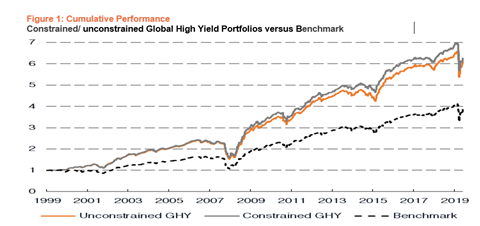A major historical fear has been that very strict exclusion or integration policies can lead to significant changes in the risk-return profile of portfolios
Environmental, social and governance (ESG) issues are increasingly important considerations for investors, with ever-increasing numbers shifting their focus from purely risk-return based objectives to the sustainability of their investments.
There are, of course, various reasons for this: a desire to incorporate a particular set of values; to meet increasingly stringent regulatory requirements; or in consideration of how the world might develop in light of important considerations such as climate change – a theme set to become even more pronounced in light of the recent US Presidential Election and the commitment of the incoming Biden Administration to address climate challenges following the disregard shown to them over the last four years.
From an academic perspective, the implications of incorporating this dimension of investing into portfolio construction have, to date, been far from conclusive.
A major historical fear has been that very strict exclusion or integration policies can lead to significant changes in the risk-return profile of portfolios – with hard-to-measure consequences – as well as more practical implications (such as increased tracking error) that provide sizeable limitations for investors.
How, then, can investors ensure both their sustainability criteria and risk-return objectives are met?
In their 2008 paper, Choueifaty and Coignard* outlined a Maximum Diversification approach to portfolio construction – building on the Modern Portfolio Theory concept set out more than 50 years earlier by Nobel Memorial Prize-winning economist Harry Markowitz.
Employing mathematical techniques, the Maximum Diversification approach is a risk-based allocation method that optimises a portfolio by maximising the number of independent effective risk factors to which it may be exposed.
The number of assets within the portfolio is, in this case, not important; rather, it is the correlation of the assets within the portfolio that matters.
The “Most Diversified Portfolio” (MDP) resulting from this approach has several distinct properties. Chief amongst these is that all the assets in the MDP’s investment universe are effectively represented, due to the portfolio being constructed on the basis of correlation between assets.
An MDP portfolio based on the S&P 500 investment universe, for example, might only be invested in 50 stocks, yet achieves maximum diversification in its investment universe as the remaining 450 stocks are more correlated to the portfolio than those it actually contains.

This means there is no need for the MDP to hold a particular security.
From a sustainable investing standpoint, this is critical and makes a Maximum Diversification approach particularly well suited to accommodating an SRI investment policy without giving up a significant market premium.
While SRI investment policies are relatively restrictive in terms of the universe of investable assets, it is still possible to construct a portfolio that is maximally diversified when there is a wide correlation spectrum of assets.
Put simply, an asset that is excluded for SRI reasons can be replaced with another asset that contributes a qualitatively similar level of diversification.
This can be applied to fossil free strategies within the global high yield space where around 20% of the investment universe would fall within a fossil fuel exclusion policy.
Benchmark-orientated strategies may find areas such as this particularly challenging; however, maximising diversification can be a shrewd method to navigate this.
While the energy sector has grown to represent a major risk concentration within high yield, taking into account potential changes in the diversification characteristics, risk profile and performance dimension after exclusions are applied is key to success.
When applying this thesis to an “unconstrained” anti-benchmark high yield portfolio (i.e. without fossil fuel exclusions applied), and a “constrained” anti-benchmark high yield portfolio (with the exclusions applied), we find, as summarized in Table 1, that there is a relatively small tracking error between them when compared with the tracking error both have versus the benchmark.

Source: TOBAM, BofAML. TOBAM calculations – from December 31, 1999 to May 28, 2020. Returns reflect back tested data for the entire time provided. Back tested results are for information purposes only. They are intended to illustrate how the Strategy may have behaved had it been launched.
Moreover, both the “constrained” and “unconstrained” portfolios maintained almost perfect correlation over the period, despite the significant active share of 31% between both portfolios.
The significantly increased level of diversification also remains extremely robust.
Finally, when looking at the simulated key return and absolute risk metrics (Figure 1), both portfolios showed a higher gross performance and lower volatility than the benchmark; and over the time period of our study there was no significant different between the portfolios on these metrics.

Source: TOBAM, BofAML. TOBAM calculations – from December 31,1999 to May 28, 2020. Returns reflect back tested data for the entire time provided. Back tested results are for information purposes only. They are intended to illustrate how the Strategy may have behaved had it been launched. Back tested performance returns and/or charts illustrating performance provided on this page are gross of management fees, sales charges and other commissions, other taxes and relevant costs to be paid by an investor are not included in the calculations. Warning: Past performance is not an indicator or a guarantee of future performance. The value of your investment and income received from it can go down as well as up and you may not get back the full amount invested. Performance details provided are in USD hedged and does not include reinvested dividends. Performance net of fees and is calculated to be 8.58% annualized. We believe this is a fair estimate of fees impact on AB GHY (constrained) Strategy focused in the HY asset class. We estimate transaction costs for the AB GHY (constrained) to be equal to 0.5% annualized.
Similar conclusions can also be reached when assessing an emerging markets equity investment universe, where fossil-fuel companies remain a relatively prominent component.
What does this mean for the sustainable strategies of the future? Investors are increasingly seeing sustainability as a key component to portfolio construction, but the application of these policies may be defined in specific and individual ways.
The investment industry is constantly looking to implement new ways to meet differing sets of sustainability requirements.
What our research demonstrates is how very restrictive SRI policies can indeed be implemented with a Maximum Diversification approach without materially impacting risk or returns.
The “only free lunch in investing” – as Markowitz once described diversification – is indeed available in a fossil-free way.
Tatjana Puhan, managing director and deputy CIO at TOBAM
* Choueifaty and Coignard, 2008: Towards Maximum Diversification, Journal of Portfolio Management, Fall, pp 40-51





























No comments yet